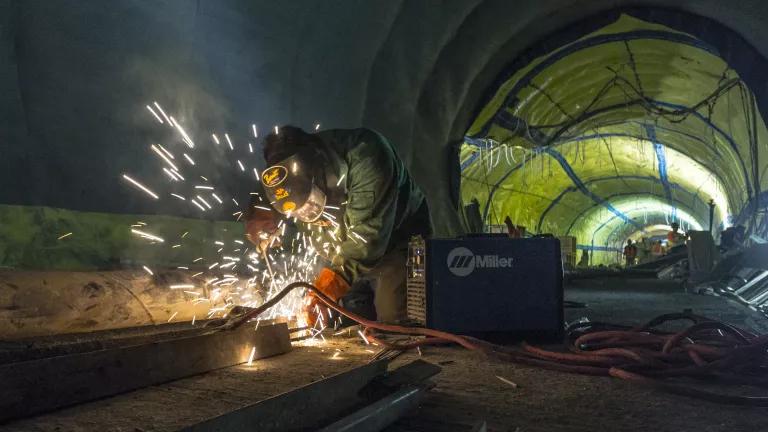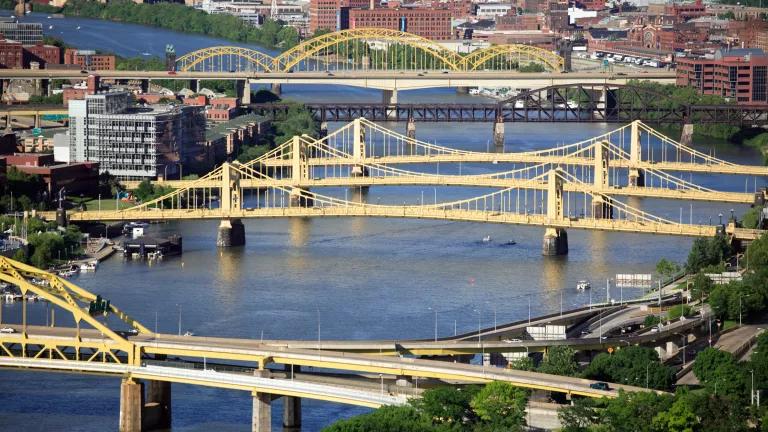Pennsylvania Takes a Crack at Making Virtual Power Plants a Reality
Linking EVs, smart homes, and other resources to the grid takes work from PJM and states. Pennsylvania is beginning to do its part.

EV chargers and solar power are two promising distributed energy technologies.
Kindel Media via Pexels
It’s been a busy month for grid decarbonization, with announcements and policies flying out the door from the U.S. Environmental Protection Agency, FERC, the White House, and the U.S. Department of Energy alike. These measures strengthen tools and pathways to build more transmission, clean up the power sector, and bring new projects online.
But there are still a myriad of solutions that remain untapped. One of them is making better use of distributed energy resources (DERs). Back in 2020, FERC’s Order 2222 required power grid operators to update their rules to take advantage of DER capabilities. But because DERs are attached to local power grids that states have authority over, that was only part of the solution. States, municipal utilities, and co-ops need to also update their “last mile” rules to finish the job.
Enter Pennsylvania. Earlier this year, the commonwealth’s Public Utility Commission (PUC) opened a docket and put forward what’s known as an advance notice of proposed rulemaking order (ANOPR), seeking feedback and comments from stakeholders on the PUC’s role in complying with FERC Order 2222. The official 60-day comment period closed just last week. It may take years for this effort to bear fruit, but it is an exciting step for the energy transition, nevertheless. The PUC is about to roll up its sleeves and get to work addressing some of the difficult questions about implementing DERs. The answers that it comes up with could help set the pace for the rest of the country to follow suit.
Defining DERs and distributed energy
Let's step back and explain DERs. Electric vehicles (EVs), cogeneration, smart appliances, rooftop solar panels, and even fully electric buildings all fit under the DER umbrella. These small-scale, electric-powered resources can lower customer bills and bring the clean air and climate benefits of renewable energy into people’s daily lives by substituting fossil fuel appliances and goods like gas stoves or combustion engine cars with cleaner options.
But the contributions of DERs to the energy transition go further than that. They can also be powered flexibly, which makes them a perfect match for renewables. Imagine EVs managing overnight charging to match the ebb and flow of wind power, or water heaters that schedule themselves around the hours when the grid is strained on a summer day. Order 2222 promises these reliability, affordability, and clean energy benefits.
When aggregated, DERs can assist in balancing electricity supply and demand while providing benefits for both consumers (via reduced costs and increased resilience) and transmission and distribution grids (by expanding capacity and flexibility to serve rising peak demand in the years ahead).
Yet, despite all their benefits, they remain wildly underutilized.
Why? Mostly because of turf battles. States regulate the distribution system, the part of the grid that delivers power to customers, while the federal government regulates the long-haul transmission system where most power plants are connected. This divide makes it difficult—sometimes impossible—for resources located on the state side of the grid to contribute to running the larger system. On top of that, grid operators have not rolled out market structures that allow widespread participation of these resources. FERC Order 2222 was adopted in 2020 to streamline connections and allow grid operators to utilize DERs. Three years later, RTOs are slowly coming into compliance.
FERC Order 2222
Order 2222 was created to fix these problems and allow smaller and nontraditional power sources to compete in markets. The rule swept away decades of confusing and contradictory rules on connecting DERs to the power grid and said simply that once a DER connects through local utility rules, it’s good to go. This is great news, since it now takes around five years and tens of thousands of dollars to make it through federal interconnection rules. For small systems, local interconnections can take two months and a few hundred dollars.
On top of that, power markets were designed for conventional large power plants and can’t handle large numbers of small resources like DERs. Order 2222 addressed that by allowing DERs to “aggregate” into larger groups and requiring grid operators to let DERs compete to provide any service they’re technically capable of.
Note the word compete: The rule gives DERs the right to provide services only when they’re cheaper than traditional power plants. FERC’s basis for issuing Order 2222 was simple old-fashioned savings. Without Order 2222, FERC found that the rules around DERs were anticompetitive, supporting utility monopolies and making power more expensive than it needed to be. Order 2222 is, at its heart, a consumer protection rule that prevents utilities from excluding new, lower-cost resources.
What does Pennsylvania need to solve?
Facing growing demand forecasts and increased strain on the grid from assets like data centers and hydrogen electrolyzers, Pennsylvania would significantly benefit from improved efficiency and flexibility to meet rising peak demand. If it’s successful, it can avoid the need for some grid build-out and better shape its own energy landscape.
The PUC’s ANOPR posed a few key questions:
- How will DERs register with state utility commissions and grid operators?
- How will DER capacity be quantified?
- How do grid operators maintain certainty and accuracy about load forecasts while accounting for and deploying flexible resources like DERs?
- When will grid operators and utility commissions directly control DERs, and when will they simply monitor and respond to use?
- What degree of flexibility should grid operators use to capture the widely varying scales and types of DERs?
As we stated in our comments: “With electricity demand projected to grow materially for the first time in two decades, fossil assets retiring and gas generators proving to be an infirm resource, the interconnection queue at PJM undergoing much-needed reform, and PJM’s long-term regional transmission planning badly in need of updating to keep pace with a changing grid, there is significant and increasing value in the potential for DERs and DER aggregations to support rapid electrification and decarbonization while reducing overall grid costs.”
Just as important are the things the PUC does not need to solve. One of the underappreciated parts of Order 2222 is that it sets a nice clean line between state and federal responsibilities. Many of the questions raised in the ANOPR have already been resolved either at PJM or at FERC, making the PUC’s task much easier.
Utilities have a long history of raising technical objections to things like DERs that turn out to be overblown. When net metering started, utilities claimed that power flowing “backward” could break their systems. Decades later, that has never happened, and net metering has supported a boom in residential solar power. When FERC ordered that demand response (DR) be treated fairly, utilities claimed that allowing competitive DR would break their systems. That never happened, and instead, competitive DR at PJM has replaced more than a dozen peaker plants and saves the public hundreds of millions of dollars every year. The PUC should learn from these lessons and not let long-solved problems delay progress.
As the largest net electricity exporter in the country, Pennsylvania is uniquely poised to benefit from the opportunity that DERs present. If it can devise solutions to bridge the utility-RTO divide on DER management, it will provide a template for states across the country to follow suit. We look forward to working with the PUC and stakeholders in the commonwealth on shaping these policies and the flexible capacity of the grid.


